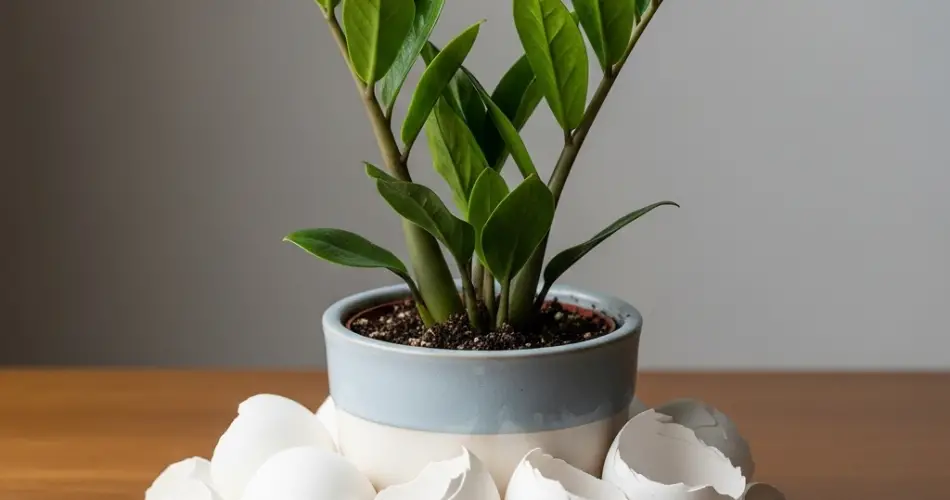The ZZ plant (Zamioculcas zamiifolia) is known for its resilience and low maintenance, making it a favorite among indoor plant lovers. However, even this hardy plant can sometimes enter dormancy or show slow growth, especially after winter. If your ZZ plant looks lifeless or hasn’t produced new shoots in a while, there’s a natural and surprising method to give it a powerful wake-up call—using a simple egg.
This organic technique helps stimulate new shoots and root growth by delivering essential nutrients directly to the plant’s root system. Here’s how to apply this easy method and what results you can expect.
Why ZZ Plants Go Dormant
ZZ plants are native to Eastern Africa and have adapted to survive long periods of drought. As a result, they can enter a dormant state when they sense unfavorable conditions, like low light or infrequent watering. During this time, they conserve energy and halt new growth.
While dormancy is normal, many plant owners become concerned when their ZZ plant remains inactive for too long. The good news is, you can help break this dormancy and encourage a flush of new leaves and roots with the right natural nutrients.
The Secret Ingredient: An Egg
One of the simplest and most effective organic fertilizers is something you probably already have in your kitchen—an egg. Whole raw eggs are packed with proteins, minerals, and micronutrients like calcium, phosphorus, and sulfur. These nutrients gradually decompose in the soil and feed the plant over time, encouraging robust growth.
While using eggs directly in the soil might sound unusual, this method has been gaining popularity among gardeners for its long-term benefits. It slowly releases nourishment, improves root strength, and helps trigger sprouting from the rhizomes.
How to Use an Egg to Boost ZZ Plant Growth
Materials Needed:
-
One raw egg (uncooked, in its shell)
-
A pot with good drainage
-
Fresh, well-draining potting soil
-
Your ZZ plant (either existing or ready to be repotted)
Instructions:
-
Prepare the Pot: Start by choosing a pot with proper drainage holes. This is important to prevent root rot, especially since you’ll be placing organic material into the soil.
-
Layer the Soil: Add a base layer of soil to the bottom of the pot.
-
Add the Egg: Place a whole raw egg (in the shell) in the center of the pot. There’s no need to crack it open—the shell will gradually break down and release nutrients as the egg decomposes.
-
Cover with Soil: Add more potting soil to cover the egg completely. Leave enough space at the top to accommodate the ZZ plant.
-
Plant the ZZ: If you’re using an existing plant, gently loosen the roots and replant it into the pot above the buried egg. If you’re planting new rhizomes, position them so that the growth points face upward.
-
Water Lightly: Water the plant just enough to moisten the soil. Avoid overwatering, especially in the first few weeks.
What to Expect
Within a few weeks, you may start to notice new shoots emerging from the base of the plant. The roots will also become more active, branching out to absorb the nutrients released from the egg.
Over time, the shell will contribute calcium, strengthening cell walls and promoting healthier growth. Meanwhile, the yolk and egg white provide organic matter and minerals that feed the plant gradually, without the need for chemical fertilizers.
Additional Tips for ZZ Plant Success
-
Light: Place your ZZ plant in bright, indirect light for optimal growth. While it can tolerate low light, a brighter spot will stimulate more rapid development.
-
Watering: Allow the soil to dry out completely between waterings. ZZ plants store water in their rhizomes, so overwatering can lead to rot.
-
Pot Size: Repotting every couple of years can encourage growth, especially when the plant has outgrown its container.
Final Thoughts
If your ZZ plant looks sluggish or hasn’t shown signs of new life, try this egg trick before resorting to synthetic fertilizers. It’s an affordable, eco-friendly, and surprisingly effective way to encourage lush, healthy growth. With just one egg, you can help your ZZ plant burst back to life and grow uncontrollably—just the way every plant parent hopes.



